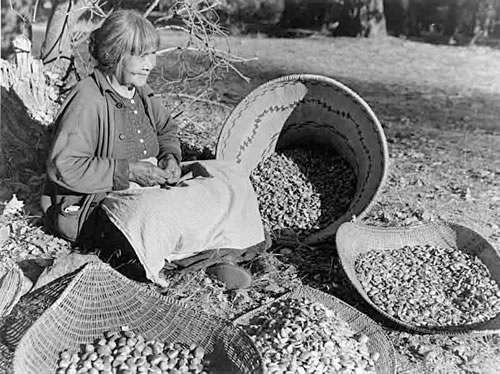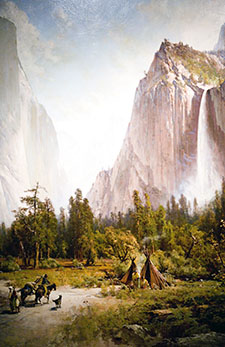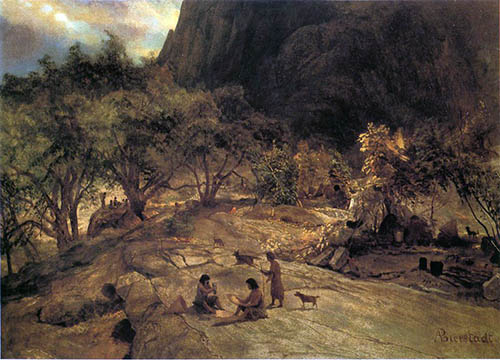How Did the Hetch Hetchy Project Impact Native Americans?
by Bruce Pierini
Sierra College Anthropology Professor
I believe that the greatest threat to the survival of American Indians — more than the wars, the disease, the poverty, the discrimination, and the European occupation — is the removal of the spiritual matrix of traditional life, the theft of the sacred. From the beginning, American Indians have centered their world views upon profound belief in the spiritual. That belief has become tentative in our time. Fewer and fewer Indian young people are acquiring those aspects of sacred being which have always defined them. I am deeply concerned to expose this theft of the sacred, and to see that American Indians, young people especially, are allowed to define themselves in terms of the spiritual values that inform their ancient heritage.
— N. Scott Momaday (Kiowa)
At first look the answer seems starkly obvious and maddeningly multifaceted. As rising waters of the Tuolumne River inundated the stunning Hetch Hetchy Valley, Natives obviously lost access to important plant and animal resources. (1) These included nutritious grasses, the much-favored black oak acorns Quercus kelloggii (2), basketry materials, deer and other wild game, an historic village site, burials, petroglyph and sacred sites. (3)
On the other hand, the building of O’Shaughnessy Dam provided construction jobs and therefore cash for Native men of the surrounding area.
However, the historic loss of the Hetch Hetchy Valley should not be seen as an isolated episode in the lives of Native people or only as a loss of subsistence habitat, as severe as those losses were. Accounting for losses in materialist terms frames the depletion of Native cultures in only one of its elements. After all, if you can’t get deer in this one valley, simply look elsewhere. No black acorns from Hetch Hetchy? Collect further along the western slope. (4)
Eurocentric "assets and liabilities" accounting seduces us into ignoring or forgetting a primary loss suffered over 200 years of crushing change: the loss of a sustaining worldview of the complex and interrelated nature of the land, all of Nature Itself, and of the people themselves. The loss of homelands at Hetch Hetchy is, at the most profound level, a loss of a centuries-old way of life sustained by an empirically-based yet mystical worldview. In this world-view "nature" and "people" don’t just happen or exist independently of one another, as we in the Western tradition understand the world.
The Hetch Hetchy Valley loss was a kind of compounded last stroke. Native people had already been impacted for at least 100 years by terrible disruption from outsiders well before the Hetch Hetchy Dam was thought of. The obliteration of the connection between that Valley and it’s people through flooding was only the latest chapter in what had been a cavalcade of historic, horrific losses.
Those deplorable assaults began with the now all-too-familiar list of historical traumas—depopulation through forced-missionization and introduced diseases like malaria and influenza, assimilation into Hispanic-period ranchos, the Gold Rush, forced relocations, removal from home areas, and absorption into the wage-labor economy outside the valley. In the twentieth century, further impacts resulted from Native children being sent away to Indian schools like the Sherman Institute in Riverside, California and the development of Yosemite National Park which excluded Natives from living in the park. (5)
How old was the way of life in Yosemite area before disruptions?
 Archaeologists began studying Yosemite’s cultural heritage in the late 1800s and by now there is a large body of detailed archaeological work that attests to habitation in the Yosemite area over the millennia. The total number of sites now listed is at 1500, and each year 25 new sites are identified. The Park states that the Hetch Hetchy area was inhabited since the end of the Pleistocene 10,000 years ago and that the sites include seasonal villages, hunting camps, sacred sites and gathering areas. (6)
Archaeologists began studying Yosemite’s cultural heritage in the late 1800s and by now there is a large body of detailed archaeological work that attests to habitation in the Yosemite area over the millennia. The total number of sites now listed is at 1500, and each year 25 new sites are identified. The Park states that the Hetch Hetchy area was inhabited since the end of the Pleistocene 10,000 years ago and that the sites include seasonal villages, hunting camps, sacred sites and gathering areas. (6)
Archaeologists cannot draw direct links to any present Native cultures from these earliest inhabitants, but it is likely that various Native lifeways were broadly similar since all were hunters and gatherers over the last several hundred years at least. By the period directly before contact, a way of life with larger villages, permanent and seasonal settlements, and a broad-based diet had been achieved among the Native groups along the foothills of the Sierra. It is difficult to know, however, if habitation sites in many higher-country areas were continually occupied or only utilized seasonally.
Who were the groups most heavily impacted by the dam?
We have to look at the archeological and historical evidence for habitation and use. For that we turn to a variety of sources with particular emphasis on the Environmental Impact Report for Yosemite National Park published in February 2010 and titled The Silver Thread—Upper Tuolumne River American Indian Land Use in Yosemite National Park (7) by Davis-King Associates and Snyder. Davis-King and Associates and Snyder (DKA) cite a comprehensive bibliography of early to late twentieth century archeological and ethnological work, part of which covers the Hetch Hetchy area. Out of this report and a few other sources a partial narrative of the historic Native peoples and the probable impacts of the dam may be glimpsed. (8)
The DKA report quotes a 1995 archeological report by Montague and Mundy, which itself relied heavily upon material prepared by former Yosemite National Park employees: Craig Bates, who summarized the park’s information known up to that time about the ethnic affiliations in the Hetch Hetchy area and Jim Snyder, who gave detailed historic era information.
During the Mariposa phase (A.D. 1200-1850), ancestors of the Sierra Miwok occupied the park area. … Upon Euro-American contact, the Central and Southern Sierra Miwok occupied the Yosemite area, with the Tuolumne/Merced watershed divide forming the boundary between the two groups. (Kroeber 1925: 442) Thus Hetch Hetchy Valley falls within the territory of the Central Sierra Miwok…permanent villages were generally established below 4,000 ft. in elevation with seasonal camps and villages scattered throughout the area currently defined as Yosemite National Park. (Merriam (1917) Mule deer and acorns were important food items although a diverse array of animal and vegetal items were used (Anderson 1988; Barrett and Gifford 1933). (9)
By the time of the Gold Rush, Native populations had precipitously declined and lifeways had eroded profoundly. Shelly Davis-King sees the Gold Rush as a kind of "final stroke" whereby surviving Native cultures were decimated. (10) Albert L. Hurtado, in Indian Survival on the California Frontier, (11) writes that before the Gold Rush Indians had outnumbered whites ten to one and that had allowed them to discourage white settlement, especially in the foothills. By the early 1850s whites outnumbered Indians by perhaps two to one. Therefore many Native persons would have witnessed the drastic historic losses of their environments, people and cultures within their own lifetimes.
In order to secure the order that would allow miners unobstructed access to the gold fields, in January 1851 Governor John McDougall established The Mariposa Battalion, charged with the subjection of Indians in the entire San Joaquin Valley. (12)
The Mariposa Battalion’s searches and raids under James D. Savage, a trader, miner and pioneer, removed Natives from the village of Ahwahneechee and made the Yosemite Valley known to outsiders; this is how the "discovery" of Yosemite Valley is most often understood. (13) Word quickly spread that stunningly beautiful valleys at about 4,000 feet were waiting to be explored. The Yosemite National Park recounts the development of tourism as slow at first, followed by early twentieth century rapid expansion due to the development of a rail link. (14)
A number of written documents and oral testimonies provide a picture of the post-Gold Rush period as one of regular usage of the Yosemite area by many different groups of Natives. Archeologist Suzanna Montague (2006), quoted by DKA, notes the high-country area was used by Mono Lake Paiute for hunting of bighorn sheep. There were also Miwok present who occasionally fought with the Paiutes, while Central Miwok people sought refuge from the Gold Rush. (15)
Davis-King and Snyder use earlier anthropological sources which indicate continual usage of the Tuolumne corridor throughout the latter part of the 19th Century by Sierra Miwok and/or Paiute groups but advise that more research needs to be done to derive a better picture of use. (16) Paden and Schlichtmann interviewed "old timers" in the 1950s who described "meat and acorns were plentiful … almost every year a visiting tribe of 50 to 100 people would come from higher in the mountains to replenish their food supply, taking the meat back with them. (17)
It is quite clear that knowing the precise ethnic affiliation of the groups occupying Hetch Hetchy Valley in the late prehistoric and early historic eras is not possible at present. A major ethnogeographic report in 2002 by ethnohistorian Brian Bibby for Yosemite National Park makes much the same point but adds there were "seven different tribal communities indicated who had "a traditional, historic relationship with the lands presently within park boundaries—The Central Sierra Miwok, Southern Miwok, Bridgeport Paiute, Mono Lake Paiute, Owens Valley Paiute, Chukchansi Yokuts and Western Mono." (18)
Bibby’s review of existing ethnographic and historic records of ethnolinguistic boundaries showed that "… the fluidity of tribal borders and the complexity of cultural and linguistic identities through time and space" would make precision impossible at the present time. (19) Moreover, inaccurate use of tribal and/or ethnolinguistic labels by 19th and 20th Century Western observers, including references to any and all Natives as "Indians" makes use of the historic record further problematic.
What is clear is that the ethnohistory of Hetch Hetchy along with the entire Yosemite area is extremely complex and a continual work-in-progress. (20)(21) Examination of the Hetch Hetchy’s archaeological and historic sites are obviously not possible due to the dam’s construction and the flooding of the Hetch Hetchy Valley.
Southern Sierra Miwok, Central Sierra Miwok, Northern Paiute, and several other groups that utilized the area as well lost a great due to the dam. In addition to the loss of important foraging range, as well as village and sacred sites, those inhabitants also lost access to spiritual or religious connections with an important center of their homelands. This latest loss capped generations of upheavals which for some earlier Natives had begun at the coastal missions. Following forced missionization and the introduction of diseases, Natives saw their populations decline dramatically. Next the Gold Rush struck a single great blow to Native cultural integrity with its forced removals, killings and relocations. The building of O’Shaughnessey Dam and the flooding of Hetch Hetchy Valley was the unfortunate culminating jolt of dispossession of their homelands and culture, which already had had a long and sad history.

Footnotes
1.The location of Hechhechi, Miwok village in the western portion of the valley, was recorded by Kroeber (1925: Plate 37). The name of the village was apparently derived from the Central Miwok word hetchetci, a name for a grass growing in Hetch Hetchy Valley from which a mush was made (Barrett and Gifford 1933:155) [DKA 37 Originally in California, State Geological Survey 1873 (1874:153)
2. M. Kat Anderson Tending the Wild: Native American knowledge and the management of California’s Natural Resources, UC Press, 2005, pg.218. She cites and edits Merriam’s species identification of Black Oak in Studies of California Indians. Berkeley, UC Press, 1955.
3. The full title of an authoritative and comprehensive 225-page report with appendices used extensively throughout this article is that of Davis-King and Snyder The Silver Thread – Upper Tuolumne River American Indian land Use in Yosemite National Park: Ethnographic Context For The Tuolumne Wild and Scenic River Comprehensive Management Plan and Environmental Impact Statement, Tuolumne County, California, February 2010, Submitted to USDI, National Park Service, Yosemite National Park, California. In that report, Shelly Davis-King describes plant resource loss immediately below the O’Shaughnessy Dam as the following: “The area immediately below O’Shaughnessy Dam is rugged and modified by construction of the reservoir. Still, there would be little below the meadows of Hetch-Hetchy that might have attracted American Indians until about a mile below the present dam, where Poopenaut Valley begins. On his way out of Hetch-Hetchy, Jepson noted a marsh below the valley in which mountain pink currant (Ribes nevadense), willows, sedges, monkeyflowers, broadiaea, daisies, grasses, and much more were flowering in late July, commenting that the “herbage [is] very charming” (Jepson, 1909: 156)…A number of rare plants are located in the Poopenaut vicinity, as located by Acree and others (2007), such as Lemmon’s wildginger, western quillwort, and false pimpernel. They (2007: 53) note the presence of Helianthus californicus. This sunflower, popular and prized with ‘local tribes’ is ‘near the only known population of Aralia californica (also a culturally important plant) [which] may mean that its occurrence at this location is due to human transport.’ By ‘the only known population,’ the authors must have meant the only known population in Yosemite, since this plant is widespread in California, and there is even another specimen from Tuolumne County in the Jepson Herbarium. Such a generalization would need to be tested by analyzing the pollens and seeds at archaeological sites there, however.”
4. Alternative foraging sites for deer, grasses, black acorns and other resources would not have been easily found by Northern Paiute who utilized the Hetch-Hetchy Valley during winter since much of their eastern areas were under heavy snowfalls. In fact, it could be argued that due to the inaccessibility of alternative winter foraging areas, the Northern Paiute may well have been even more affected by the loss of the Hetch-Hetchy Valley than Miwok groups.
5. Dolan Eargle’s 2008 Native California: An Introductory Guide to the Original Peoples from Earliest to Modern Times writes that “The National Park Service insists Native peoples can not live in the parks unless they are employed there. This jeopardizes the very heart of Indian cooperation with the federal government. How is it possible without hypocrisy to hire Indian rangers to talk about “their” land, but forbid Native peoples from living on that very same ground? A federally unrecognized but vibrant community of Southern Sierra Miwok peoples lived and raised their families on their historic homelands in Yosemite National Park until just a few decades ago…..In 2005 the Park Service came to an agreement with the Native Yosemite people which allowed them 30-years of nominal control over a small portion of their land, but only for ceremonial and tribal purposes.” (190)
6. Yosemite National Park website http://www.nps.gov/yose/historyculture/index.htm, retrieved, March 14, 2013
7. I am deeply indebted to Shelly Davis-King for her cooperation in allowing me to use her work and for commenting critically on an earlier draft of this article. Any errors in summarizing her work are entirely mine.
8. A comprehensive or detailed overview of the Native archaeology and history of Yosemite National Park and its Hetch-Hetchy Valley here is simply not possible because they have yet to be written. The subjects are enormous and resist succinct treatment. For example, In the “Archeological Synthesis” portion of the Davis-King and Snyder report, the authors recount a massive amount of work done by Kathleen Hull and Michael Moratto in 1999 in their Archeological Synthesis and Research Design for Yosemite National Park. Those original writers make clear that identifying the ethnic identity of prehistoric groups making use of the area is difficult for a variety of reasons and requires more archeological analysis to establish.
According to early anthropological reports, in A.D. 1850, the area of Yosemite National Park was held mainly by the Central and Southern Sierra Miwok (Barrett 1908; Kroeber 1921, 1925; Levy 1978; Merriam 1917,1967,1976). Three other ethnic groups—the Western Mono (Monache), Northern Paiute (Paviotso), and Washoe—also occupied or regularly visited parts of Yosemite (Napton 1978: 70-112). It seems likely from more recent accounts that the Northern Paiute were prime inhabitants and/or visitors.
13. The account generally used is that of Lafayette Bunnell, a physician who accompanied the Battalion in those forays. Bunnell’s book of reminiscences was written 30 years later and titled Discovery of the Yosemite, and the Indian War of 1851, Which Led to the Event. Reprinted by Yosemite Association from the 1911, 4th Edition, published by Gerlcher, Los Angeles. Eargle quotes Savage in 1891speaking of the fires his men had set destroying the Ahwanichee’s winter acorn provisions: “The sight of these fires is more beautiful to me than any other.” (190)
14. Yosemite National Park website, http://www.nps.gov/yose/historyculture/index.htm, retrieved, March 14, 2014. “The rugged terrain challenged many early travelers, with just a few—only 650 from the mid-1850s to mid-1860s—making the journey to Yosemite Valley by horseback or stagecoach. By 1907, construction of the Yosemite Valley Railroad from Merced to El Portal eased the journey, thereby, increasing visitation.”
15. Montague 2006b:4 [ DKA 54] “Summer subsistence practice (primarily hunting), traveling for warfare and festivals, trade and escaping enemies or drought are documented in high country activities. Two routes, the Mono Trail and an unnamed trail….traverse the Tuolumne River corridor….The Mono Lake Paiute used the high country for hunting bighorn sheep, and in 1869 John Muir reported a group of hunters at Soda Springs in Tuolumne Meadows. Warfare between the Miwok and Paiute occurred at Hetch-Hetchy, while Central Sierra Miwok people temporarily retreated to higher elevations to escape the onslaught of the Gold Rush”
16. “Occupation of Hetch Hetchy by the Sierra Miwok and/or Paiute may have persisted during the post-contact period. No serious research has been completed to address this question, but a few pieces of information indicate that native people did use the valley at least into the end of the nineteenth century. First, the location of Hechhechi, Miwok village in the western portion of the valley, was recorded by Kroeber (1925: Plate 37). ….A temporal framework for the occupation and abandonment of the village, however, is not known. Also Whitney [Josiah Whitney in his geological survey of the area] stated in 1874 that Paiute Indians still used the valley to gather acorns, since they had driven out the resident Miwok. [DKA 37] originally in California State Geological Survey 1873 (1874: 153)
17. Paden, Irene D., and Margaret E. Schlichtmann, The Big Oak Flat Road. An Account of Freighting from Stockton to Yosemite Valley. San Francisco, California [no publisher listed], 1955 Copyright by Emil P. Schlichtmann. Davis-King and Snyder quote the work of Paden and Schlichtmann who, in 1995, recorded interviews with “old timers” about the Big Oak Flat vicinity (portions of the Big Oak Road are now part of present California Highway 120). [DKA 100]
18. “What does seem clearly indicated by archeological, ethnographic and historic evidence is that two major groups, the Southern Sierran Miwok and the Northern Paiute, utilized the Hetch-Hetchy area for the collection of deer, acorns, a variety of plants and other uses. …. Bibby wrote that seven different tribal communities indicated they have a traditional, historic relationship with the lands presently within park boundaries—the Central Sierra Miwok, Southern Sierra Miwok, Bridgeport Paiute, Mono Lake Paiute, Owens Valley Paiute, Chukchansi Yokuts and Western Mono.” [DKA 59]
19. Quoting Montague citing Bibby: “Paiutes assumed control of Hetch-Hetchy following Euroamerican contact. Just upstream of the Hetch Hetchy Valley along the Tuolumne River, Pate Valley may have been used seasonally or year-round by Miwok and Paiute people. The high country saw regular use by Miwok and Paiute groups for hunting and trading, with Tuoumne Meadows the location of inter-tribal gatherings into the 1880s.” [DKA 54]
20. Mr. David Andrews has sent this author information which Mr. Andrews believes supports the idea that the Paiutes were the late 19th Century inhabitants of the Hetch-Hetchy area. He is cited in the DKA report and represents a group known as the Yosemite-Mono Lake Paiute Community that is not organizationally or politically associated with the Mono Lake Kutsadika tribe (formerly known as the Mono Lake Paiute Community).
21. “While there are certainly Miwok families with ancestral ties to this portion of the Tuolumne River, there are as many Paiute families with similar ancestral ties. In fact, intermarriage between these two groups was common. These ties continued into the historic period, and within the last century Yosemite Indian men of Miwok and/or Paiute heritage, such as Jack Wilson, Alvis Brown, Lloyd Parker and “Junior” Telles, worked on the road crew into Hetch-Hetchy and on other construction-related tasks...it will be important to future analysis to present both Paiute and Miwok ethnohistory in cultural overviews.” [DKA 39]
Images Credits
- Maggie Howard, www.nps.gov
- Paintings, public domain
